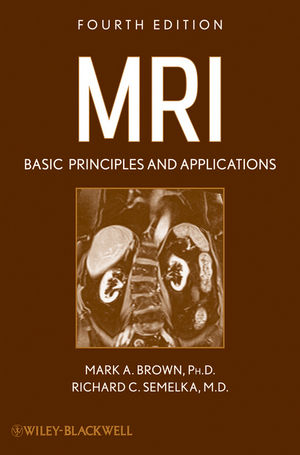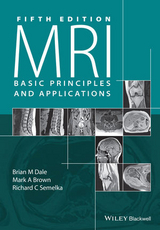
MRI
Wiley-Blackwell (Verlag)
978-0-470-50098-9 (ISBN)
- Titel ist leider vergriffen;
keine Neuauflage - Artikel merken
Fourth Edition Brings This Popular Guide Thoroughly Up To Date With The Latest MRI Findings, Techniques, And Applications
For its Fourth Edition, the acclaimed MRI: Basic Principles and Applications has been rigorously revised, enabling readers to quickly master the principles and take advantage of all the latest MRI applications. Among the new materials are fresh and updated discussions on 3D imaging, real-time imaging, cardiac imaging, and parallel acquisition techniques. In addition, readers will find dozens of brand-new images to illustrate key concepts. Moreover, clinical protocols have been thoroughly updated and revised to reflect current methodologies.
Throughout the book, readers will find easy-to-follow coverage of all the latest findings, technologies, and techniques, including: *
Nephrotoxic effects of gadolinium-based contrast media *
New scan techniques, including radial scanning *
Parallel acquisition and cardiovascular imaging techniques *
New applications, including spin tagging and diffusion tensor imaging *
3 Tesla and 7 Tesla scanning *
Hardware innovations, including large-scale array coils *
New motion compensation techniques
With its clear explanations and ample illustrations, this Fourth Edition maintains all the hallmarks of the previous edition that have made this book a fixture in MRI labs around the world. Students and practitioners from physicians to radiologists to technicians will gain a full, accurate understanding of the underlying physics and the clinical applications of MRI, all with a minimum of mathematical formulas and technical details.
From Reviews of the Third Edition
"...successful in transferring key ideas in an undaunting and progressive manner ...thoroughly deserves a place on the bookshelf." NMR in Biomedicine, Vol 17(4), June 2004
"...it will reward the reader with an understanding of the principles underpinning nuclear magnetic resonance.
" Yale Journal of Biology and Medicine, May 2003
Mark A. Brown, PhD, is Senior Technical Instructor at Siemens Medical Solutions Training and Development Center and also holds an adjunct research professorship in the Department of Radiology, University of North Carolina School of Medicine. His research interests include relaxation and exchange phenomena and in vivo nuclear magnetic resonance spectroscopy and imaging.
Richard Semelka, MD, is Director of Magnetic Resonance Services, Professor, and Vice Chairman of Radiology at the University of North Carolina-Chapel Hill Medical School. He received his medical degree and residency training in radiology in his native Canada at the University of Manitoba, and completed a clinical research fellowship in MRI of the body at the University of California at San Francisco. Dr. Semelka has authored over 150 peer-reviewed articles, 4 textbooks, and is an internationally acclaimed authority in the field.
Preface.
Preface to the Third Edition.
Preface to the Second Edition.
Preface to the First Edition.
1. Production of Net Magnetization.
2. Concepts of Magnetic Resonance.
3. Relaxation.
3-1. T1 Relaxation and Saturation.
3-2. T2 Relaxation, T2 Relaxation, and Spin Echoes.
4. Principles of Magnetic Resonance Imaging: Part 1.
4-1. Slice Selection.
4-2. Readout or Frequency Encoding.
4-3. Phase Encoding.
4-4. Sequence Looping.
5. Principles of Magnetic Resonance Imaging: Part 2.
5-1. Frequency-Selective Excitation.
5-2. Composite Pulses.
5-3. Raw Data and Image Data Matrices.
5-4. Raw Data and k Space.
5-5. Reduced k-Space Techniques.
5-6. Reordered k-Space Filling Techniques.
5-7. Other k-Space-Filling Techniques.
5-8. Phased-Array Coils.
5-9. Parallel Acquisition Methods.
6. Pulse Sequences.
6-1. Spin Echo Sequences.
6-2. Gradient Echo Sequences.
6-3. Echo Planar Imaging Sequences.
6-4. Magnetization-Prepared Sequences.
7. Measurement Parameters and Image Contrast.
7-1. Intrinsic Parameters.
7-2. Extrinsic Parameters.
7-3. Parameter Trade-offs.
8. Signal-Suppression Techniques.
8-1. Spatial Presaturation.
8-2. Magnetization Transfer Suppression.
8-3. Frequency-Selective Saturation.
8-4. Nonsaturation Methods.
9. Artifacts.
9-1. Motion Artifacts.
9-2. Sequence/Protocol-Related Artifacts.
9-3. External Artifacts.
10. Motion Artifact Reduction Techniques.
10-1. Acquisition Parameter Modifi cation.
10-2. Triggering and Gating.
10-3. Flow Compensation.
10-4. Radial-Based Motion Compensation.
11. Magnetic Resonance Angiography.
11-1. Time-of-Flight MRA.
11-2. Phase-Contrast MRA.
11-3. Maximum-Intensity Projection.
12. Advanced Imaging Applications.
12-1. Diffusion.
12-2. Perfusion.
12-3. Functional Brain Imaging.
12-4. Ultrahigh Field Imaging.
12-5. Noble Gas Imaging.
13. Magnetic Resonance Spectroscopy.
13-1. Additional Concepts.
13-2. Localization Techniques.
13-3. Spectral Analysis and Postprocessing.
13-4. Ultrahigh Field Spectroscopy.
14. Instrumentation.
14-1. Computer System.
14-2. Magnet System.
14-3. Gradient System.
14-4. Radio-frequency System.
14-5. Data Acquisition System.
14-6. Summary of System Components.
15. Contrast Agents.
15-1. Intravenous Agents.
15-2. Oral Agents.
16. Safety.
16-1. Base Magnetic Field.
16-2. Cryogens.
16-3. Gradients.
16-4. RF Power Deposition.
16-5. Contrast Media.
17. Clinical Applications.
17-1. General Principles of Clinical MR Imaging.
17-2. Examination Design Considerations.
17-3. Protocol Considerations for Anatomical Regions.
17-4. Recommendations for Specifi c Sequences and Clinical Situations.
References and Suggested Reading.
Index.
| Erscheint lt. Verlag | 8.6.2010 |
|---|---|
| Zusatzinfo | ill |
| Verlagsort | Hoboken |
| Sprache | englisch |
| Maße | 157 x 233 mm |
| Gewicht | 402 g |
| Themenwelt | Medizinische Fachgebiete ► Radiologie / Bildgebende Verfahren ► Kernspintomographie (MRT) |
| ISBN-10 | 0-470-50098-0 / 0470500980 |
| ISBN-13 | 978-0-470-50098-9 / 9780470500989 |
| Zustand | Neuware |
| Haben Sie eine Frage zum Produkt? |
aus dem Bereich



